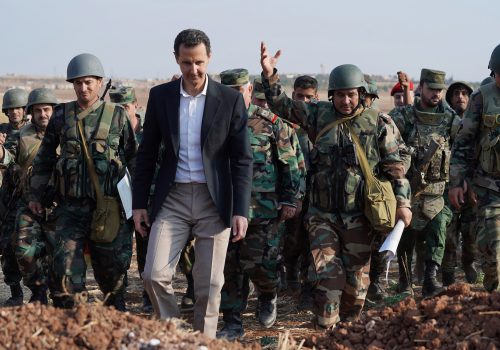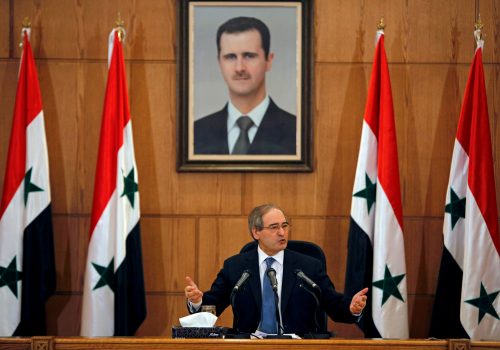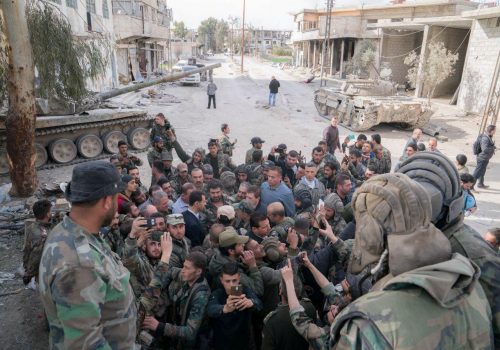January 11, 2021
The Assad regime faces a Rubik’s Cube of challenges in 2021
After almost a decade of conflict, Bashar al-Assad’s regime appears to have weathered the existential threat posed by the 2011 Syrian uprising and the ensuing armed struggle. Today, the question for the regime is one no longer centered on surviving militarily or worrying about foreign powers seeking its removal. Rather, it is one of how to manage the volatile reality resulting from its pyrrhic victory.
Following substantial military support from Russia and Iran, the Assad regime has, since 2015, been able to reassert control over key swathes of territory. However, the coming year will likely present the regime with a perplexing stalemate as it attempts to navigate a political, economic, and security landscape beset with a Rubik’s Cube of challenges. Among these are a staggering economy, an incessant public health crisis, growing social discontent, and a limited capacity for military advancement.
Economic downfall and social discontent
The Syrian economy is at its worst levels since 2011. Compounded by systemic corruption and mismanagement, the conflict has led to an unprecedented meltdown of the Assad regime’s economic activity, which has declined by more than 60 percent. Syria’s currency, the Syrian pound, is estimated to have lost 97 percent of its prewar value, while the poverty rate has soared to 90 percent.
The reverberations of such economic atrophy will likely continue to be felt in 2021. Amid further debilitation of state institutions, the regime’s scramble to provide services and maintain supply chains is expected to persist. Its limited access to oil and wheat fields—most of which are outside of its territorial grasp—will deepen Damascus’ fiscal imbalances, inability to provide key services amid food and energy insecurities, and dependence on credit imports from foreign allies, like Iran and Russia. The implementation of a new round of sanctions by the United States under the Caesar Act has exacerbated the Assad regime’s financial incapacitation, in addition to hindering the momentum towards normalization, both regionally and internationally. As such, the regime’s hopes to receive foreign funding for reconstruction are likely to diminish.
In this light, Syrians in regime-held areas are growing resentful of a government unable to provide basic services. Years of war, economic depression, and increasingly transparent corruption are driving unprecedented rebukes, even from within ‘loyalist’ communities. Across the country, state-subsidized bakeries, one of the few remaining protections, face daunting lineups, queues at gas stations can extend for kilometers, and diesel for heat, cooking, and transportation is becoming virtually unaffordable. Moreover, wheat and fuel shortages have both sustained and been sustained by a thriving black-market economy, where subsidized commodities are often sold for higher prices to wealthier segments of society, resulting in even less availability for ordinary Syrians.
While the regime does not care much about the well-being of its people, it recognizes that the status quo is untenable. Given the depletion of state coffers, the regime has been utilizing, however unsuccessfully, diversionary tactics as a means to contain growing restlessness. Assad’s failure to actively crackdown on its own clientelist networks fuels resentment across Syrian society, while any moves to do so would, at best, be problematic. In this context, the regime will need to balance public resentment and the profiteers that largely keep it alive.
COVID-19
Against this backdrop of economic decline, the regime will encounter difficulties stemming from the spread of the coronavirus and sustaining its cover-up of the crisis. Initially embedded in hospitals, the secret police spearheaded efforts to artificially deflate numbers. It monitored cases, interrogated patients, and coerced doctors into lying about the causes of death—all to project the illusion of control. Since then, its predatory policies have systematically undermined the response to the pandemic by forcing public sector employees and teachers to work and by nefariously diverting community-donated resources—such as oxygen cylinders—to the regime’s favored networks. Though the affluent are better situated to survive, the Syrian state’s broken health infrastructure means that no one is fully immune. Damascus, Deir Ezzor, Sweida, Aleppo, Latakia, and Tartous all witnessed outbreaks throughout 2020.
At the end of December of last year, the Syrian health ministry reported over ten thousand cases of COVID-19 in regime-held areas, with public health indicators pointing to an incoming second wave. As the regime continues to prioritize the war and neglect the public health crisis, infection cases are only expected to increase, given the little restrictions put in place to mitigate the spread of the virus and the inadequacy of the health care system, which is also critically short on staff and supplies. While talks between Damascus and Moscow in regard to acquiring the Russian-made COVID-19 vaccine were reported, it appears that there is no clear plan for an immunization program.
Military stalemate
Today, the Assad regime holds approximately 65-70 percent of war-torn Syria. Earlier in 2020, following gains his forces made in northern Syria, Assad vowed to recapture the rest of country and declare “complete victory” over opposition forces. However, his rhetoric notwithstanding, there are strong indications to suggest that 2021 will bring considerable limitations on the regime’s ambition to recapture territory.
In the northwest, the past year has witnessed some notable advances for the Assad regime. With Russian air support, regime forces seized two strategic cities, Maaret al-Numan and Saraqib, giving them undisputed access to the M-5 highway that connects Damascus and central Syria with Aleppo. Throughout the past two years, the regime and Russia have crystallized a pattern of maneuvers on the Idlib front in which limited offensives are followed by de-escalation agreements brokered by the latter and negotiated with its Turkish counterparts. In lieu of the army’s inability to make sweeping gains, this consistently repeated formula has enabled Damascus to gradually extend and consolidate military control and Moscow to redefine demarcation lines with each new truce.
However, further regime advances in the coming year may face complete hindrance by Turkey or come at a much higher cost. While Turkey and Russia—patrons of two opposing sides on the frontline—maintained coordination throughout 2020, it appears that the regime will be challenged by the imposition of a Turkish threshold that restricts their push further north. Ankara has significantly invested in Syria’s northwest and is unlikely to compromise on key locations in Idlib province, particularly as it holds a distinct interest in preventing greater refugee movements towards its southern border.
Additionally, Moscow would likely prioritize its complex and fragile relationship with Ankara, which includes preserving joint patrols in certain areas. This effectively humbles the regime’s operational ambitions, as it is aware that it can neither solidify its military gains nor launch offensives without Russian air cover. Operations not sanctioned by Russia risk substantial military casualties.
Nevertheless, along the Idlib-Latakia-Hama axis the regime may still be able to make minor advances. The likelihood is that the regime would gradually attempt to progress south of the M-4 highway, another strategic road that cuts through several areas in the north. Yet, the prospects of success on this objective are slim, and it remains to be seen how Russia and Turkey would make trade-offs over situational interests, when unaligned, in the coming year.
In the south, security challenges to the Assad regime are to be expected, as its nominal authority is tested against rising hostilities and restive populations. Though the regime absorbed control of the Daraa governorate through a Russian-mediated “reconciliation agreement” in 2018, the past two years have shown the ability of former rebels to sustain an armed resistance. Since then, sporadic attacks conducted against pro-Assad personnel have increased in frequency and intensity. While many former rebels have been reintegrated into the state’s military structure as part of the Eighth Brigade of the Fifth Corps—a Russian-designed hybrid model of security governance under which they operate semi-autonomously—abuses and provocations by Assad-aligned forces serve as an incubator for ongoing opposition.
In 2021, the regime will likely face a renewed struggle in this arena, particularly if Moscow expands its involvement with local security forces, with whom it holds a separate chain of command. The regime’s apprehensions—shared by the Iran-Lebanese Hezbollah axis—over Sunni mobilization—potentially intended to dilute Alawite-Shia hegemony in Damascus and the south—will need to be weighed against aggravating its Russian sponsors, without whom its tenuous authority is sure to endure precipitous obstacles.
What is more, the regime will probably confront ongoing challenges in the northeast, where it has engaged in reconciliatory talks over the past two years with the Syrian Kurds. While Assad hoped to gradually penetrate areas controlled by the Kurdish-led Syrian Democratic Forces (SDF) amid American attempts to withdraw US troops, the incoming Joe Biden administration is likely to maintain its presence in the region and advance diplomatic efforts between the SDF and Turkey. This would yield some much-needed leverage for the United States and allow continued stabilization operations against the resurgence of the Islamic State of Iraq and al-Sham (ISIS). And, of course, the regime’s calculus for the northeast is ultimately restrained by Russia, which is involved in a balancing act between Ankara and the Syrian Kurdish leadership, in part aimed at challenging the US military presence in Syria.
In 2021, the regime is set to struggle with a web of obstacles. Internally and externally, this will require careful maneuvering and measured policies. As Assad seeks to campaign for Syria’s farcical elections—which would violate the international agreement on a settlement to the conflict per United Nations Security Council Resolution 2254—he appears unable to coherently address the numerous challenges set for the new year. With each additional turn of the Rubik’s Cube, the regime may wind up one step further from achieving the delicate equilibrium needed to preserve its longevity.
Nizar Mohamad is a Toronto-based independent Middle East analyst who specializes in Syrian politics and security. Mohamad has previously worked on Canada’s Syrian refugee project. Follow him on Twitter: @NizarMohamad1.
Abdulrahman al-Masri is an independent analyst, focusing on politics and security issues in the Middle East. Follow him on Twitter: @AbdulrhmanMasri.
Image: A picture of Syrian President Bashar al-Assad is seen on a door of a butcher shop, during a lockdown to prevent the spread of the coronavirus disease (COVID-19), in Damascus, Syria April 22, 2020. Picture taken April 22, 2020. REUTERS/Yamam Al Shaar


